The interior of the cité de l'espace - Toulouse
[EN]
Hello, I hope you are well. Today I will continue to talk about the interior of the space museum in Toulouse. In the first part, I already explored some of the fascinating exhibits, but there is still much more to see. Now, I'm going to show you other interesting details and curiosities that I found during my visit. From innovative equipment to simulators, each piece has its own story and role in space exploration. Let’s discover more of this incredible world of science and technology together.
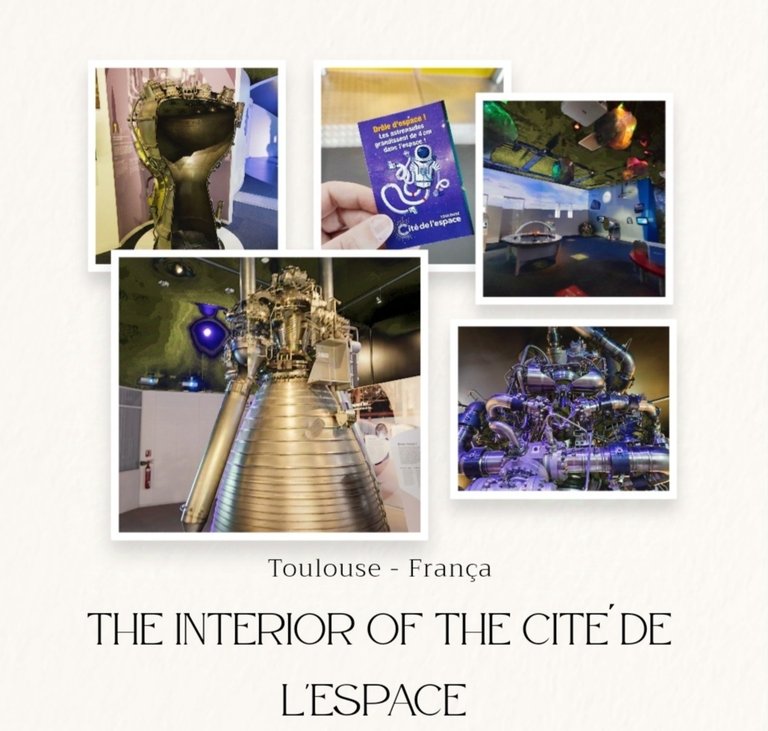
Here we can see an impressive piece of a rocket engine. This object is an essential part of space engines, responsible for generating the enormous force needed to launch rockets away from Earth. Its structure is robust, made of materials resistant to extreme heat. In the museum, there is a lot of information about how these engines work and their importance in space missions. The exhibition allows visitors to appreciate up close the technological complex that makes travel to space possible. It's fascinating to see how everything is built to withstand such challenging conditions.
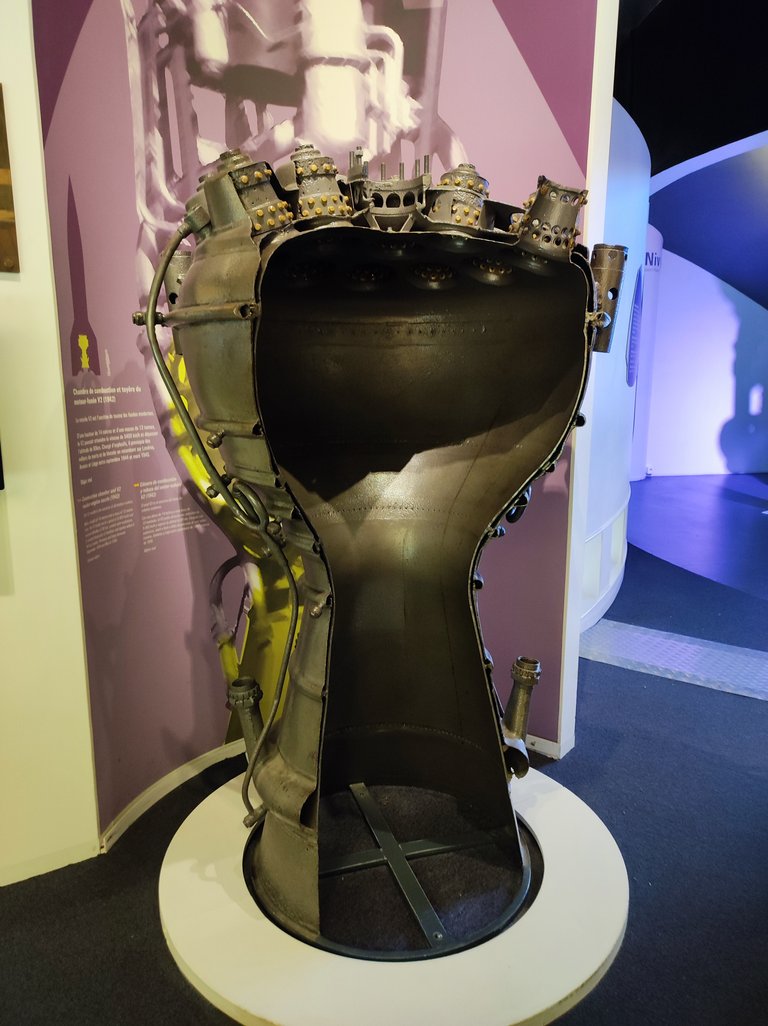
Here it shows another part of the engine, but with a focus on the intricate details of the propulsion system. This tangle of tubes and valves is crucial to regulating fuel flow, ensuring the engine runs properly during launch. The engineering involved is extremely advanced, and museum visitors can learn how each piece plays a vital role. The look of the pipes and metal parts conveys a feeling of strength and precision. It's a unique opportunity to explore the science behind space missions.
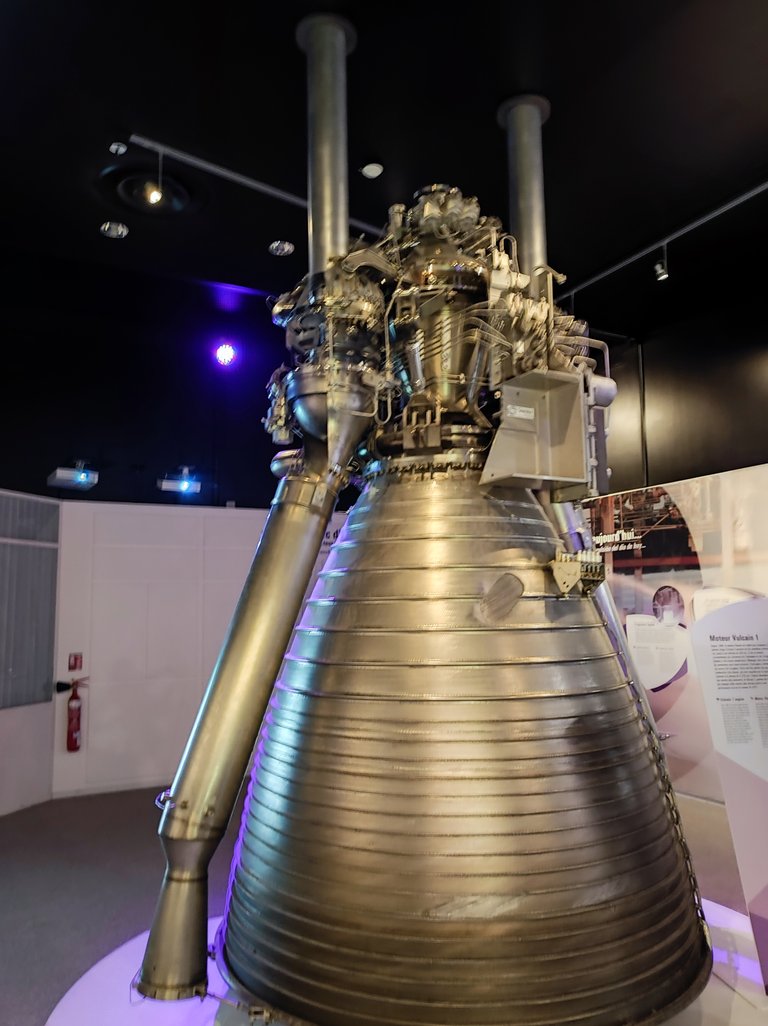
You can also find the cone of a rocket engine, one of the most recognizable parts of the set. This component, known as the nozzle, is responsible for directing the hot gases that are expelled from the engine, generating thrust for the rocket. Its conical shape is designed to maximize engine efficiency by increasing gas exit velocity. The exhibition at the Toulouse museum highlights the importance of aerodynamic design and how it affects the overall performance of rockets during liftoff and space travel.
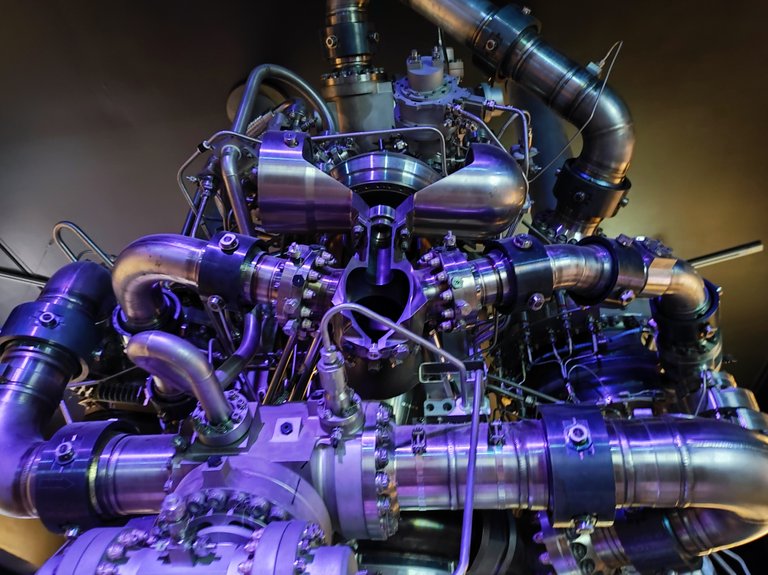
we also see a large model of a complete rocket. These rockets are used to launch satellites and spacecraft into orbit. At the museum, there are a series of exhibits dedicated to explaining the operation and history of these rockets, from the first launches to the most modern technologies. Visitors can see the grandeur of these machines up close and better understand how space exploration has evolved over the years. It's an inspiring experience, especially for those who dream of the stars and space.
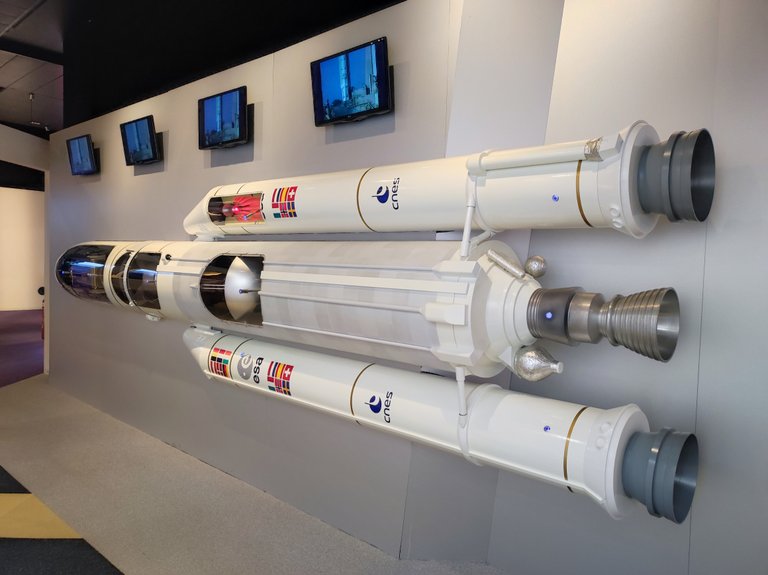
Here we see a small illuminated globe that represents the Earth and the Moon. The display shows how the two celestial bodies are connected, especially with regard to the phases of the Moon and how it influences our planet. The light simulates the Sun and how it illuminates the Earth and Moon at different angles. This exhibit helps visitors better understand how lunar cycles work and their impact on phenomena such as tides. It's a simple, visual way to explain complex concepts about astronomy.
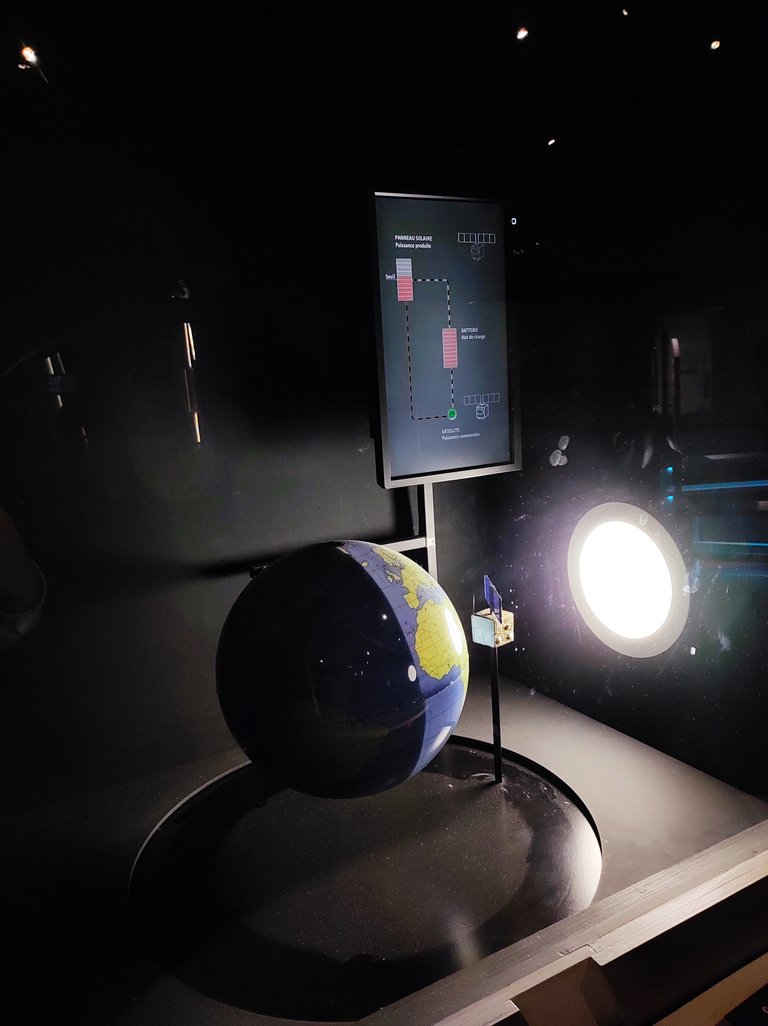
There is a satellite on display. This model shows how satellites used in space missions are built, covered in a golden layer that helps protect the equipment from extreme temperatures in space. They are essential for communications, weather forecasting and monitoring the Earth. At the museum, visitors can learn about the role of these satellites in space exploration and everyday life. It's fascinating to see how this modern technology plays a crucial role in our lives, even though we are so far from Earth.
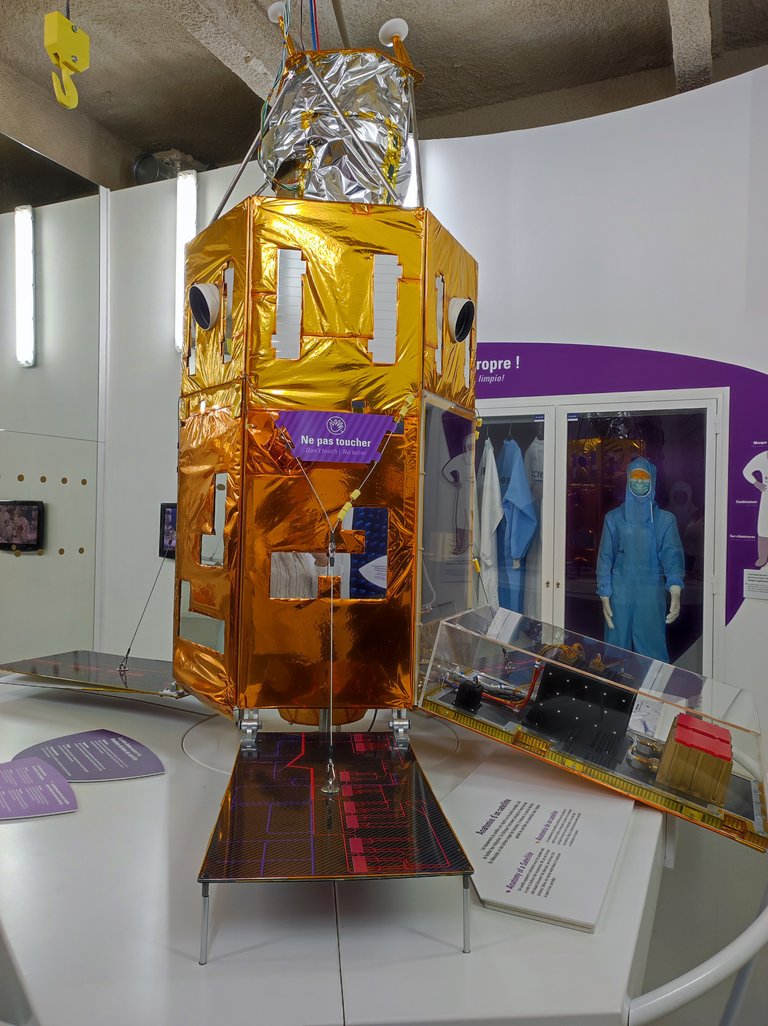
We can also see a cloud suspended from the ceiling of the museum, probably representing the Earth's atmosphere or meteorological phenomena in space. This captivating display helps illustrate the importance of the atmosphere and how it interacts with celestial bodies and space activities. The light that falls on the cloud highlights its cores and creates an almost magical sensation. At the museum, explanations accompany the exhibition, allowing visitors to learn more about the space environment and the atmospheric conditions that affect the Earth.
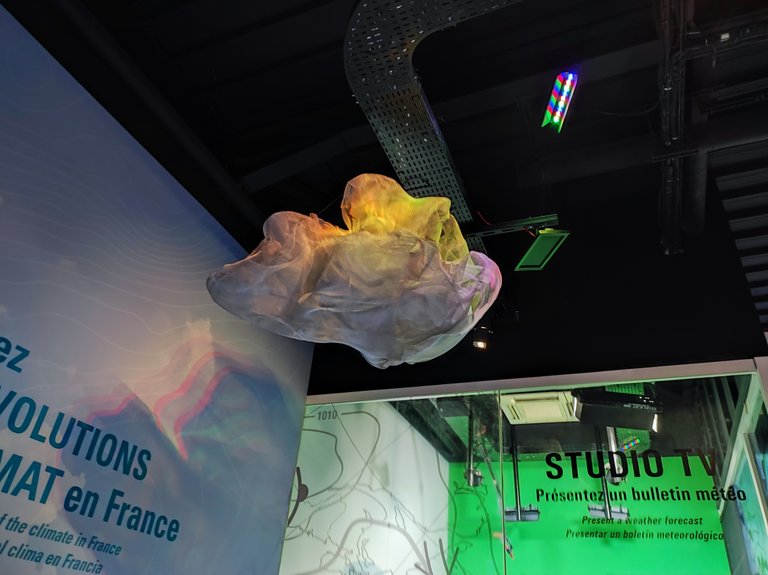
In this photo the photo shows a transparent dome-shaped structure, probably an interactive display about planets or stars. Inside, there appears to be a small model that represents some spatial phenomenon. This type of display allows visitors to interact directly with the content, making the experience more engaging. At the museum, there are several installations like this, where we can explore different aspects of space and astronomical science in a fun and educational way.

we see a colorful projection of a planet, Earth, with patterns that appear to represent weather phenomena or ocean currents. This exhibit helps show how scientists use data to better understand changes in the planet's climate and weather patterns. Through these images, visitors can learn about the human and natural impact on Earth's climate, as well as better understand global challenges related to the environment and climate change.
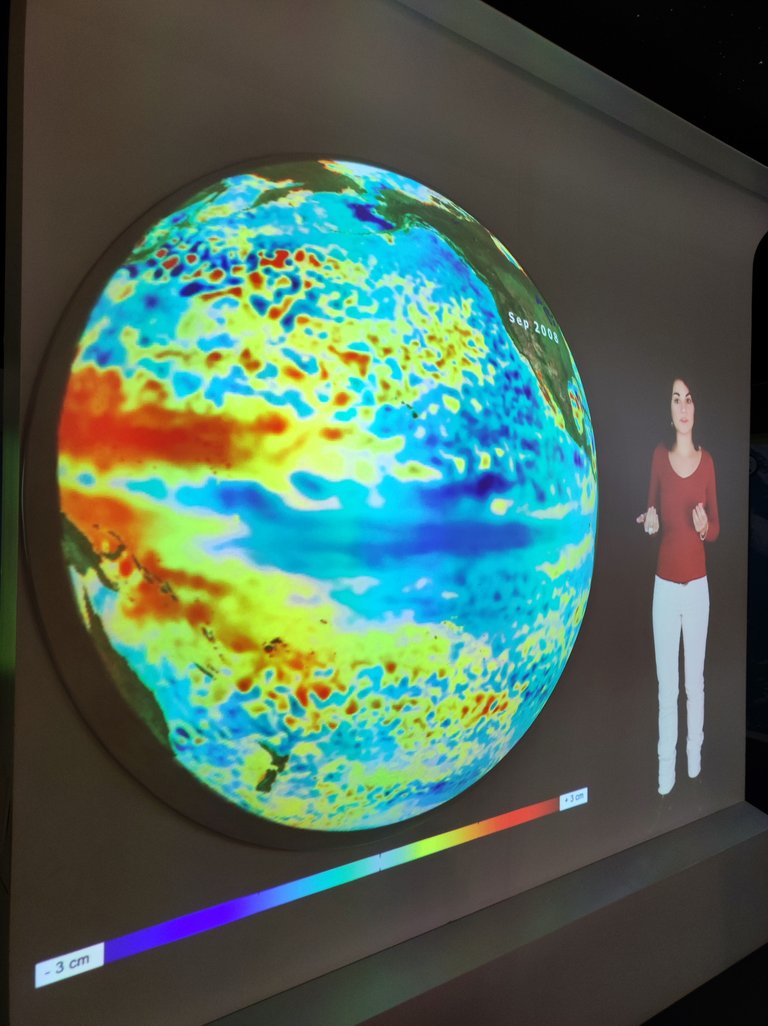
There is a control console with a screen and a steering wheel, which simulates controlling a spaceship. The panel contains buttons and levers, showing that visitors can interact and simulate the experience of driving a ship in space. This type of exhibit is interactive, allowing people to feel closer to the real astronauts' experience of piloting spacecraft and carrying out operations in outer space. It's an engaging way to show what it's like to be in command of a space mission.
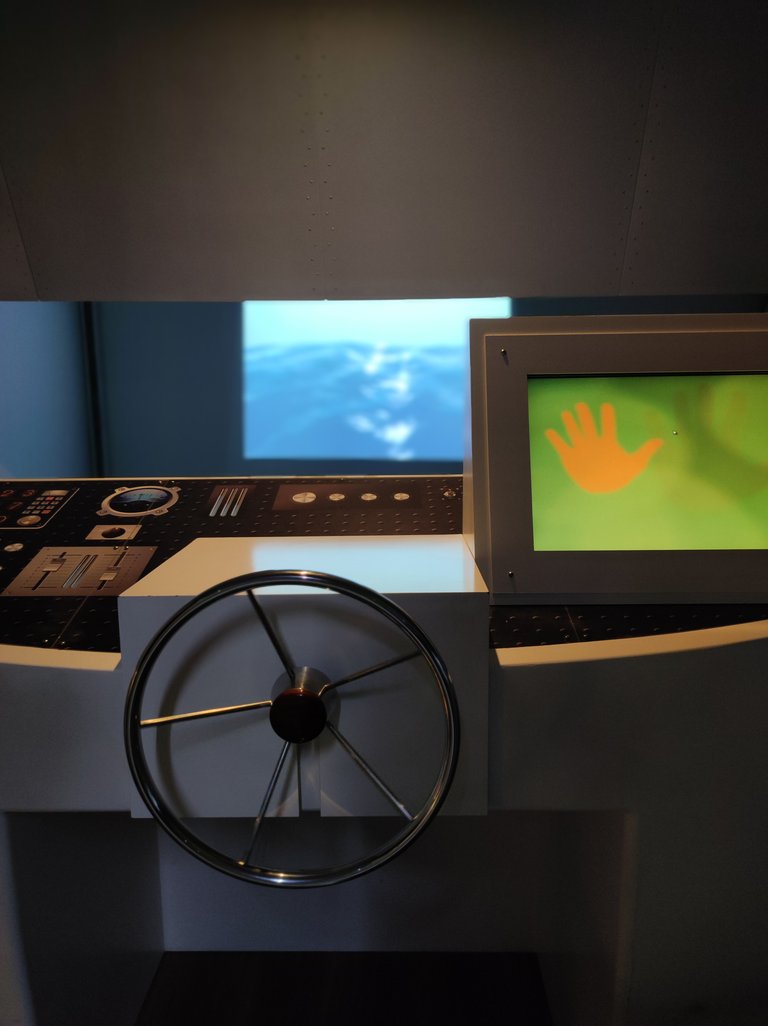
Here we can see cabinets and compartments, like those found in space stations. These cabinets are used to store essential equipment and materials for astronauts during their missions. At the museum, this showcase an idea of how limited and organized space is essential to life on a space station, where every inch counts. Visitors learn about how life works under these conditions, from food storage to the equipment needed for scientific experiments in space.
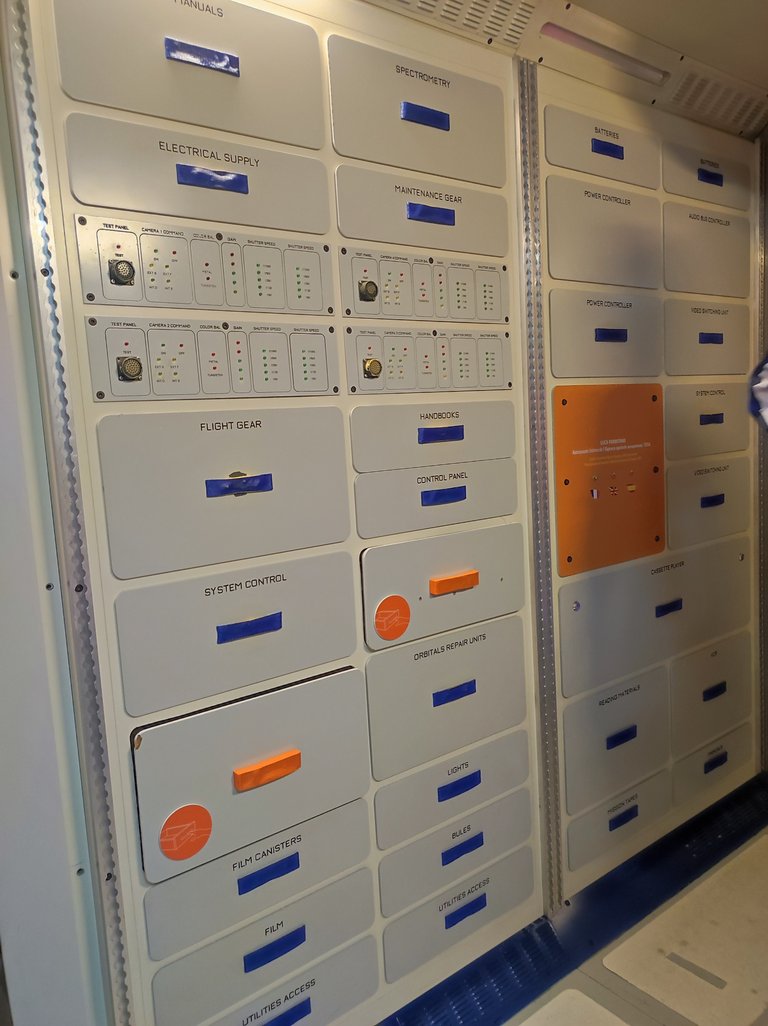
The last photo shows a drone. It has propellers that suggest it could be used for flights in low-gravity environments or with thin atmospheres, such as Mars. These drones are important for exploring inhospitable terrain and help capture data and images in places where traditional vehicles could not reach. At the museum, he demonstrates how technology has advanced to enable remote exploration of other planets, and visitors can understand the crucial role of drones in future space exploration missions.
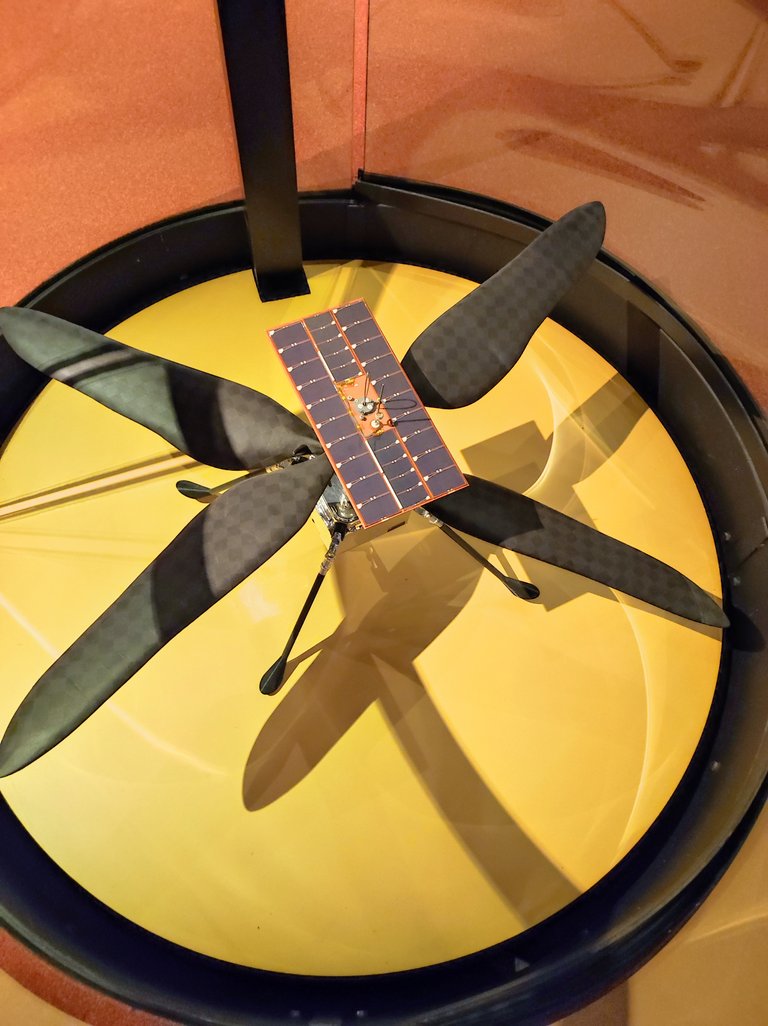
I hope you liked it, see you soon friends 😃
[PT-BR]
Olá, espero que você esteja bem. Hoje continuarei falando sobre o interior do museu espacial de Toulouse. Na primeira parte já explorei algumas das fascinantes exposições, mas ainda há muito mais para ver. Agora vou mostrar outros detalhes e curiosidades interessantes que encontrei durante minha visita. De equipamentos inovadores a simuladores, cada peça tem sua própria história e papel na exploração espacial. Vamos descobrir mais deste incrível mundo da ciência e da tecnologia juntos.

Aqui podemos ver uma peça impressionante de um motor de foguete. Este objeto é parte essencial dos motores espaciais, responsável por gerar a enorme força necessária para lançar foguetes para longe da Terra. Sua estrutura é robusta, feita de materiais resistentes ao calor extremo. No museu há muitas informações sobre o funcionamento desses motores e sua importância nas missões espaciais. A exposição permite ao visitante apreciar de perto o complexo tecnológico que possibilita a viagem ao espaço. É fascinante ver como tudo é construído para resistir a condições tão desafiadoras.

Aqui mostra outra parte do motor, mas com foco nos intrincados detalhes do sistema de propulsão. Esse emaranhado de tubos e válvulas é crucial para regular o fluxo de combustível, garantindo que o motor funcione corretamente durante a partida. A engenharia envolvida é extremamente avançada e os visitantes do museu podem aprender como cada peça desempenha um papel vital. O visual dos tubos e peças metálicas transmite uma sensação de resistência e precisão. É uma oportunidade única de explorar a ciência por trás das missões espaciais.

Você também pode encontrar o cone de um motor de foguete, uma das partes mais reconhecíveis do conjunto. Esse componente, conhecido como bocal, é responsável por direcionar os gases quentes que são expelidos do motor, gerando empuxo para o foguete. Seu formato cônico foi projetado para maximizar a eficiência do motor, aumentando a velocidade de saída do gás. A exposição no museu de Toulouse destaca a importância do design aerodinâmico e como ele afeta o desempenho geral dos foguetes durante a decolagem e as viagens espaciais.

também vemos um grande modelo de um foguete completo. Esses foguetes são usados para lançar satélites e espaçonaves em órbita. No museu há uma série de exposições dedicadas a explicar o funcionamento e a história desses foguetes, desde os primeiros lançamentos até as mais modernas tecnologias. Os visitantes podem ver de perto a grandiosidade dessas máquinas e entender melhor como a exploração espacial evoluiu ao longo dos anos. É uma experiência inspiradora, principalmente para quem sonha com as estrelas e o espaço.

Aqui vemos um pequeno globo iluminado que representa a Terra e a Lua. O display mostra como os dois corpos celestes estão conectados, principalmente no que diz respeito às fases da Lua e como ela influencia o nosso planeta. A luz simula o Sol e como ele ilumina a Terra e a Lua em diferentes ângulos. Esta exposição ajuda os visitantes a compreender melhor como funcionam os ciclos lunares e o seu impacto em fenómenos como as marés. É uma maneira simples e visual de explicar conceitos complexos sobre astronomia.

Há um satélite em exibição. Este modelo mostra como são construídos os satélites utilizados em missões espaciais, cobertos por uma camada dourada que ajuda a proteger os equipamentos das temperaturas extremas no espaço. Eles são essenciais para comunicações, previsão do tempo e monitoramento da Terra. No museu, os visitantes podem aprender sobre o papel desses satélites na exploração espacial e na vida cotidiana. É fascinante ver como esta tecnologia moderna desempenha um papel crucial nas nossas vidas, mesmo estando tão longe da Terra.

Também podemos ver uma nuvem suspensa no teto do museu, provavelmente representando a atmosfera terrestre ou fenômenos meteorológicos no espaço. Esta exibição cativante ajuda a ilustrar a importância da atmosfera e como ela interage com os corpos celestes e as atividades espaciais. A luz que incide sobre a nuvem destaca seus núcleos e cria uma sensação quase mágica. No museu, explicações acompanham a exposição, permitindo ao visitante conhecer mais sobre o ambiente espacial e as condições atmosféricas que afetam a Terra.

Nesta foto a foto mostra uma estrutura transparente em forma de cúpula, provavelmente uma exibição interativa sobre planetas ou estrelas. No interior, parece haver um pequeno modelo que representa algum fenômeno espacial. Esse tipo de display permite que os visitantes interajam diretamente com o conteúdo, tornando a experiência mais envolvente. No museu existem diversas instalações como esta, onde podemos explorar diferentes aspectos do espaço e da ciência astronómica de uma forma divertida e educativa.

vemos uma projeção colorida de um planeta, a Terra, com padrões que parecem representar fenômenos climáticos ou correntes oceânicas. Esta exposição ajuda a mostrar como os cientistas usam os dados para compreender melhor as mudanças no clima e nos padrões climáticos do planeta. Através destas imagens, os visitantes podem aprender sobre o impacto humano e natural no clima da Terra, bem como compreender melhor os desafios globais relacionados com o ambiente e as alterações climáticas.

Há um console de controle com tela e volante, que simula o controle de uma nave espacial. O painel contém botões e alavancas, mostrando que os visitantes podem interagir e simular a experiência de dirigir uma nave no espaço. Este tipo de exposição é interativa, permitindo que as pessoas se sintam mais próximas da experiência real dos astronautas ao pilotar naves espaciais e realizar operações no espaço sideral. É uma forma envolvente de mostrar como é estar no comando de uma missão espacial.

Aqui podemos ver armários e compartimentos, como os encontrados nas estações espaciais. Esses armários são usados para armazenar equipamentos e materiais essenciais para os astronautas durante suas missões. No museu, isso mostra uma ideia de como o espaço limitado e organizado é essencial para a vida em uma estação espacial, onde cada centímetro conta. Os visitantes aprendem como a vida funciona nessas condições, desde o armazenamento de alimentos até os equipamentos necessários para experimentos científicos no espaço.

A última foto mostra um drone. Possui hélices que sugerem que poderia ser usado para voos em ambientes de baixa gravidade ou com atmosferas finas, como Marte. Esses drones são importantes para explorar terrenos inóspitos e ajudam a capturar dados e imagens em locais onde os veículos tradicionais não conseguem chegar. No museu, ele demonstra como a tecnologia avançou para permitir a exploração remota de outros planetas, e os visitantes podem compreender o papel crucial dos drones em futuras missões de exploração espacial.

Espero que tenham gostado, até breve amigos 😃
Congratulations, your post has been added to WorldMapPin! 🎉
Did you know you have your own profile map?
And every post has their own map too!
Want to have your post on the map too?
Obrigado por promover a comunidade Hive-BR em suas postagens.
Vamos seguir fortalecendo a Hive
Bzzz, que incrível essa exposição! Ouvir sobre os motores de foguete é como uma descida ao mundo do ZinZin! ¡Espero ver mais! #hivebr
Obrigada
Your post was manually curated by @Shiftrox.
Delegate your HP to the hive-br.voter account and earn Hive daily!
🔹 Follow our Curation Trail and don't miss voting! 🔹
Hello! Please check this post's pin on the map. It's in Toulouse, France, right? But your pin is located in the middle of Algeria.
Hi, I was wrong. Thank you very much for the warning